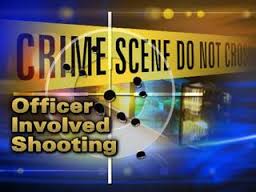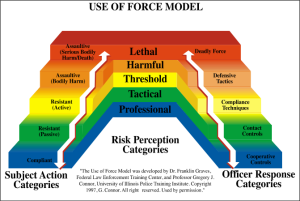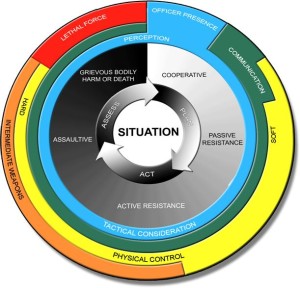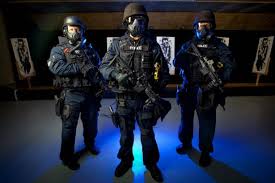 The shooting death of unarmed, black teenager, Michael Brown, by white police officer, Darren Wilson, in Ferguson, Missouri, on August 9, 2014, caused an international uproar and a microscopic evaluation of law enforcement’s use of force parameter.
The shooting death of unarmed, black teenager, Michael Brown, by white police officer, Darren Wilson, in Ferguson, Missouri, on August 9, 2014, caused an international uproar and a microscopic evaluation of law enforcement’s use of force parameter.
I’m not going into details of this particular, tragic event, but I can say from personal experience what takes place in the training and execution of deadly force application.
 Regular police officers undergo a thorough, basic training in the use of their service weapons and in the evaluation of situations where they may be required to use a lethal response. Most officers graduate the academy with a reasonable proficiency with their sidearm and perhaps a shotgun and carbine rifle. They go through yearly qualifications to maintain their skill and, thankfully, most go through their entire service without ever firing a shot.
Regular police officers undergo a thorough, basic training in the use of their service weapons and in the evaluation of situations where they may be required to use a lethal response. Most officers graduate the academy with a reasonable proficiency with their sidearm and perhaps a shotgun and carbine rifle. They go through yearly qualifications to maintain their skill and, thankfully, most go through their entire service without ever firing a shot.
Special Weapons and Tactics (SWAT) or Emergency Response Teams (ERT), like I served on, are trained to a significantly higher degree of proficiency, but the principles of using deadly force are the same.
 All officers are taught to assess their response to a dangerous situation by applying the Use Of Force Continuum. This is graphed out in either a lineal or a circular model and is a standard that provides guidelines as to how much force may be used against a resisting subject in a given situation.
All officers are taught to assess their response to a dangerous situation by applying the Use Of Force Continuum. This is graphed out in either a lineal or a circular model and is a standard that provides guidelines as to how much force may be used against a resisting subject in a given situation.
The assessment process has the officer perceiving the incident and considering the tactical response they need to evoke. Perception ranges from a cooperative subject, to one who is passively resisting, actively resisting, becoming assaultive, or presenting grievous bodily harm or death to the officer.
 The officer’s tactical response can vary from simple communication, to soft or hard physical control, to the use of intermediate weapons such as the baton, pepper spray or Taser, right to the lethal force of shooting the subject. This is all fine and well in the classroom but in Real Life and on Real Street, this stuff can go down in seconds.
The officer’s tactical response can vary from simple communication, to soft or hard physical control, to the use of intermediate weapons such as the baton, pepper spray or Taser, right to the lethal force of shooting the subject. This is all fine and well in the classroom but in Real Life and on Real Street, this stuff can go down in seconds.
I don’t know how many times I’ve heard someone say “Couldn’t the police have just shot to wound, not to kill?” Well, that’s just not a reality given that the average police shootings occur within seven feet and in under two seconds.
The basic principle of use-of-force training is to condition a person so they’ll respond appropriately in a situation where they have little time to think. When a situation hits the danger level which requires a police officer to pull the trigger, there’s no time left to gamble on something fancy.
Contrary to popular belief, police officers are not trained to shoot to kill.
 They’re trained to neutralize the subject and the most efficient way to do this is to aim for the center of body mass. Not the head. Not the elbow. Not the knee. Not the groin. And not to shoot the gun out of the bad guy’s hand.
They’re trained to neutralize the subject and the most efficient way to do this is to aim for the center of body mass. Not the head. Not the elbow. Not the knee. Not the groin. And not to shoot the gun out of the bad guy’s hand.
The center of mass, or ‘CX’ as it’s known on the firing range, is the easiest to hit and has the quickest effect in putting the subject down and out of commission. It’s where the vital organs are and where the central nervous system is most vulnerable.
Very few police shootings are found to be an unjustified use of force. In fact, many subjects survive a police bullet. The situation in Ferguson, Missouri, may be debatable about its justification, but all are in agreement that it was tragic.


I found your writing intriguing. I am a newly published author. I would like to invite you to visit my book’s FB Page and share. It deals primarily with “Protocols of Color” which is an instruction guide for decreasing negative outcomes during police interactions. I am working on Vol. 2 which deals with Transparency. Your views would be welcome. Thank you.
Quandara J Ingram
Author: When Blue Lights are Flashing “All Lives Matter”
I’ve seen Flashpoint, many times in fact. Great show. Don’t think it’s still on in the U.S., though. At least, I haven’t seen it for over a year on the channel lineup. I wondered about that term, too. “Got the solution”. Like the first person commented, it makes sense, but seems like an odd thing to say. This is great info, Garry, as usual. Thank you for sharing it! I’ve been neck-deep in revisions after reading an amazing book. I’ll fill you in later on my discovery. You’re going to love it!
Hi Sue – I’m curious about what you’re up to?
I’ve cross-trained with multi-national forces and haven’t seen lingo like ‘Got the solution’ or cutesy-stuff used. It’s more mottos, like the US Marines ‘Semper Fi’ or the British 22nd Special Air Services ‘Who Dares Wins’. From what I’ve seen, when shit goes down there’s more filfy, foul, four-letters flying than you can possibly concoct.
This is great information, thank you! I love the show, Flashpoint. I believe it is in syndication on Ion channel. Are you familiar with it? It is a Canadian crime show about the Strategic Task Force, like the American SWAT. My roommate and I often wondered why they said, “I’ve got the solution” when they had their eyes and weapons on a subject. I know what it means, obviously, but the words, seem different than what one might expect. Thanks again for a thought provoking post! 🙂
Thanks for the comment, Becky. I haven’t seen Flashpoint, but then I really don’t watch much TV. I was involved in the early stage of the RCMP’s Emergency Response Team (ERT) development. The mindset of the time was to avoid the term SWAT as it sounded too aggressive and Americanized, so they came up with ERT. Someone suggested Fast Action Response Team but the acronym stunk 😉